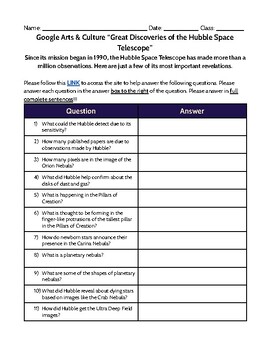Google Arts & Culture “Great Discoveries of the Hubble Space Telescope” PDF
Mrs Glitterski Classroom
7 Followers
Resource Type
Standards
NGSSMS-ESS1-3
NGSSHS-ESS1-3
NGSSHS-ESS1-1
NGSSHS-ESS1-2
Formats Included
- PDF
- Internet Activities
Pages
2 pages
Mrs Glitterski Classroom
7 Followers
Compatible with Digital Devices
The Teacher-Author has indicated that this resource can be used for device-based learning.
Description
This worksheet will walk students through the article. The questions are in the order of the article.
Total Pages
2 pages
Answer Key
Not Included
Teaching Duration
1 hour
Report this resource to TPT
Reported resources will be reviewed by our team. Report this resource to let us know if this resource violates TPT’s content guidelines.
Standards
to see state-specific standards (only available in the US).
NGSSMS-ESS1-3
Analyze and interpret data to determine scale properties of objects in the solar system. Emphasis is on the analysis of data from Earth-based instruments, space-based telescopes, and spacecraft to determine similarities and differences among solar system objects. Examples of scale properties include the sizes of an object’s layers (such as crust and atmosphere), surface features (such as volcanoes), and orbital radius. Examples of data include statistical information, drawings and photographs, and models. Assessment does not include recalling facts about properties of the planets and other solar system bodies.
NGSSHS-ESS1-3
Communicate scientific ideas about the way stars, over their life cycle, produce elements. Emphasis is on the way nucleosynthesis, and therefore the different elements created, varies as a function of the mass of a star and the stage of its lifetime. Details of the many different nucleosynthesis pathways for stars of differing masses are not assessed.
NGSSHS-ESS1-1
Develop a model based on evidence to illustrate the life span of the sun and the role of nuclear fusion in the sun’s core to release energy that eventually reaches Earth in the form of radiation. Emphasis is on the energy transfer mechanisms that allow energy from nuclear fusion in the sun’s core to reach Earth. Examples of evidence for the model include observations of the masses and lifetimes of other stars, as well as the ways that the sun’s radiation varies due to sudden solar flares (“space weather”), the 11-year sunspot cycle, and non-cyclic variations over centuries. Assessment does not include details of the atomic and sub-atomic processes involved with the sun’s nuclear fusion.
NGSSHS-ESS1-2
Construct an explanation of the Big Bang theory based on astronomical evidence of light spectra, motion of distant galaxies, and composition of matter in the universe. Emphasis is on the astronomical evidence of the red shift of light from galaxies as an indication that the universe is currently expanding, the cosmic microwave background as the remnant radiation from the Big Bang, and the observed composition of ordinary matter of the universe, primarily found in stars and interstellar gases (from the spectra of electromagnetic radiation from stars), which matches that predicted by the Big Bang theory (3/4 hydrogen and 1/4 helium).



